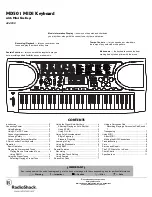
Appendices
988
Dynamic MIDI 1
Source
(7–7b):
KARMA On/Off
Dynamic MIDI 1
Bottom
(7–7b):
000
Dynamic MIDI 1
Top
(7–7b):
127
Dynamic MIDI 1
Action
(7–7b):
Momentary
Dynamic MIDI 1
Destination
(7–7b):
Repeat Stop
Dynamic MIDI 1
Polarity
(7–7b):
–
Module Stop & Repeat Stop
[Momentary]
Combines the effects of Module Stop and Melodic
Repeat Stop (above), so that all note generation from
the assigned module(s) will be immediately
terminated.
Note:
You can use a source from any of the three
groups, but typically it will be the Controller Group.
Module Pause
[Momentary, Toggle]
Operating the selected source controller when the
KARMA function is operating will pause the playback
of the KARMA Module.
When the KARMA module parameter “Run”
(Combination/Sequencer 7–1c) is turned Off
(unchecked), the KARMA module will continue
operating internally without pausing. This means that
when “Run” is turned On (checked), the phrase or
pattern will not resume from where the phrase or
pattern had stopped, bur rather the phrase or pattern
will continue playing from the moment at which the
setting was turned On. In contrast, Dynamic MIDI
Module Pause makes the phrase or pattern resume
playing from where it was stopped.
Example
Move the joystick in the +Y direction to pause and then
resume the phrase produced by the currently-
operating KARMA module.
Settings
(Program mode)
Dynamic MIDI 1
Source
(7–7b):
JS+Y (CC#01)
Dynamic MIDI 1
Bottom
(7–7b):
000
Dynamic MIDI 1
Top
(7–7b):
127
Dynamic MIDI 1
Action
(7–7b):
Momentary
Dynamic MIDI 2
Destination
(7–7b):
Module Pause
Dynamic MIDI 2
Polarity
(7–7b):
+
When you move the joystick all the way in the +Y
direction, the phrase will pause. When you return the
joystick to the center, the phrase will resume playing.
Chord Scan
[Continuous]
Control the chord analysis that controls the phrase or
pattern generated by the KARMA module.
Normally, each KARMA module detects chords by
notes that are input in the key zone (Program 7–1a,
Combination/Sequencer 7–1b) specified for each
module. Instead of this key zone, you can control
chord detection using the note range specified by the
Bottom
and
Top
(7–7b) of the source.
Chord analysis affects the operation of the following
GE parameters. (
☞
GE Guide)
• Note Series Group: “Chord Shift”
• Note Series Group: “Note Type” Scalic or Scalic 2
• Note Series Group: “Filter Notes”
• CCs/Pitch Group: “Chord Shift”
• Repeat Group: “Chord Shift”
• Drum Group: “NTT (Note Table Transposition)
On/Off”
For KARMA modules affected by the Chord Scan
specified here, the key zone note input specified for
each module will not be used for chord detection on
that module.
Note:
Select the Note, Note Inside Zone, or Note
Outside Zone note group as the source. The
Polarity
(7–7b) setting will be ignored. Chord analysis cannot
be controlled if you select a source from the JS+Y
(CC#01)…JS X controller group, a note group other
than the above, or the Velocity…Velocity Outside Zone
Velocity group.
Example
Select a GE of “GE Type” 3: Real-Time (
☞
VNL), and
use the keyboard to input the chord that will control
the phrase or notes being played by Melodic Repeat.
Settings
(Program mode)
Dynamic MIDI 1
Source
(7–7b):
Note Outside Zone
Dynamic MIDI 1
Action
(7–7b):
Continuous
Dynamic MIDI 1
Destination
(7–7b):
Chord Scan
KeyZone
Btm
(7–1a):
C4
KeyZone
Top
(7–1a):
C9
Play the high range of the keyboard above C4
(specified as the key zone) to trigger phrases and notes
produced by the KARMA function. At this time, play
the lower range of the keyboard to control the chord of
the phrase or notes in realtime. (Playing the lower
range of the keyboard will not produce sound, but will
only control the chord.) This allows you to play the
lower range of the keyboard to vary the chord while
“Melodic Repeat” is producing an extended phrase,
letting you control the development of the phrase.
Smart Scan
[Continuous]
As with Chord Scan, this controls the chord analysis
that controls the phrase or pattern generated by the
KARMA module.
Normally, each KARMA module will detect chords
from notes that are input in the key zone specified for
each module (Program 7–1a, Combination/Sequencer
7–1b). Instead of this key zone, you can use notes in the
range specified by the source
Bottom
and
Top
(7–7b) to
control chord detection.
Note input by key zone or chord detection by Chord
Scan requires one or more notes, while Smart Scan
requires three or more notes to be input in a given area.
In general when you perform using both hands, the
chord will change when you play three or more notes
in either hand. For example if you press C4 for key
zone note input or Chord Scan, the chord will be
detected as C maj. In contrast, Smart Scan will not
detect a chord when you press C4, but will (for
example) detect C Maj when you simultaneously press
C4/E4/G4.
In addition, Smart Scan takes into consideration the
keyboard location and number of notes that are
played, allowing more sophisticated and intuitive
control of the timing of chord detection and the bass
note handling.
Содержание Electronic Keyboard
Страница 1: ...Parameter Guide Parameter Guide ...
Страница 2: ......
Страница 180: ...Program mode EXi 170 ...
Страница 290: ...EXi STR 1 Plucked String 280 ...
Страница 572: ...Sequencer mode 562 ...
Страница 700: ...Global mode 690 ...
Страница 751: ...Insert Effects IFX1 IFX12 Routing 741 Fig 2 3a Fig 2 3b ...
Страница 902: ...Effect Guide 892 ...
















































